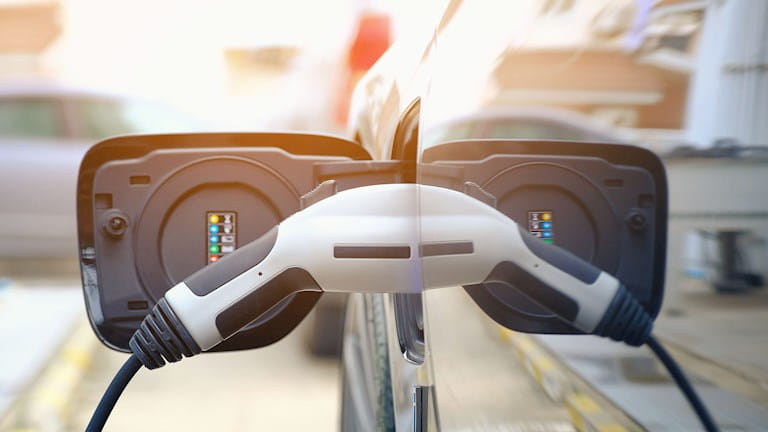Northwestern U.S. Utility, Electric Vehicles
A win-win EV program for the utility and its customers, projecting 30% gains in EV adoption
What We Did
To support state clean energy and decarbonization goals, our client wanted to design and launch an electric vehicle (EV) fleet and commercial program that promotes the adoption of EVs. The utility needed to present a compelling program design that appealed to various types of fleet and commercial customers—while also balancing program and incremental costs—to benefit all customers. That’s when the utility called West Monroe.
We’ve helped a broad range of utilities develop EV programs. So, we quickly tapped the tools and perspectives from that work to help this utility:
- Analyze variables such as vehicle types, fleet size, miles travelled, and dwell times in order to anticipate load profiles
- Develop a business case model that evaluates the financial impact of fleet conversion from the customer and utility perspectives
- Create an interactive EV program design console enabling the utility’s EV program team to quickly see the impacts of design decisions for customers and the utility
- Introduce a standalone EV Total Cost of Ownership tool that the utility can use to engage customers
In just 12 weeks, our work set the stage for delivering both financial value and better air quality.
25%
projected reduction in effort to obtain regulatory approval due to clear articulation of costs and benefits
30%
projected increase in EV fleet conversion due to program design and value proposition
20%
projected reduction in customer acquisition costs through use of the EV Total Cost of Ownership model
Project Timeline
The Challenge
Our client, like many utilities, is exploring ways to fast-track transformation to clean energy by providing incentives for replacing today’s greenhouse gas-emitting fleets with EVs.
As a result, the utility wanted to be able to assess the effectiveness of various EV program designs for the light-duty, medium-duty, and heavy-duty vehicle sectors. It also wanted to understand the degree of turnkey infrastructure (e.g., utility and customer site improvements, EV chargers) and rebate incentives it can offer prospective EV fleet customers—without unfairly burdening its broader customer base.
An Undeniably Different Approach
We not only have significant EV project experience and perspective. We have turned that know-how into useful tools for planning and accelerating EV initiatives, including a business case model based on multiple perspectives—both the utility and its customers. Our unique blend of experience in financial business case modeling, EV programs, and utility operations allows us to support our clients across the EV program journey. That’s why this utility called us for assistance.
We put our tools to use, working with the utility to develop a financial model and business case analysis that allows the utility to shape mutually beneficial EV fleet programs and take a proactive role in driving market transformation. And because we were using established capabilities, we were able to produce the insight that the utility needed in just 12 weeks.
The output:
- Aggregated EV charging profiles across the various fleet segments that assess impacts to the utility’s existing load profile
- EV load projections that provide insight for system planning
- A financial model and business case that translates EV adoption forecasts into EV load and revenue, determines incremental system costs, and calculates the revenue requirement for EV program costs
- An interactive dashboard that allows utility users to quickly test EV program design variables (incentive type, levels, subsidies, rate structures, etc.), view projected outcomes, and configure potential programs
Returns You Can Measure
The utility can now calculate, with accuracy, the investment necessary in EV program incentives to make fleet electric conversion cost-effective, without unfairly burdening its broader customer base. That means it can move quickly to design win-win EV programs that maximize value for both prospective EV fleet owners and all utility customers - accelerating much-needed market transformation and achieving its greenhouse gas-reduction targets sooner.
This exercise was just the first step in creating future value. Now the utility is ready to benefit by:
- Reducing the effort associated with regulatory approval of EV program filings. Our work produced a defensible model and analysis that will streamline filing development, evidentiary proceedings, data requests, and stakeholder interventions.
-
Lowering the risk of revenue loss and customer dissatisfaction. The utility can better alleviate concerns about cross-subsidization (e.g. customers at large footing the bill for incentives to EV fleet owners).
- Increasing EV fleet conversions. The utility can develop more effective marketing initiatives that convey a clear value proposition and expectations around total cost of ownership.
- Reducing customer acquisition costs and accelerating the pace of adoption. Using our total cost of ownership tool will streamline and speed up the conversion process.





.png?mw=400&mh=100&iar=0&as=1&hash=C61648826932876E29BEB8C11B66F69E)

